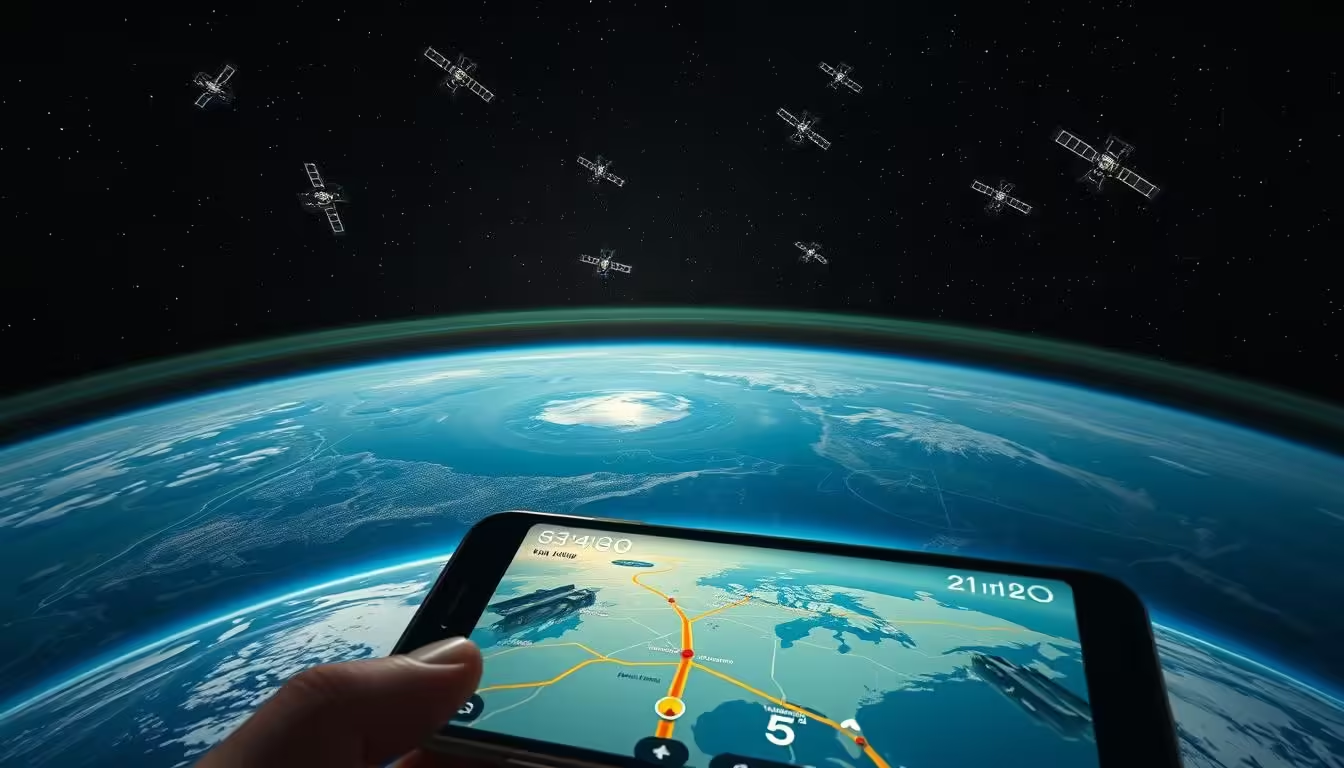The Global Positioning System (GPS) has revolutionized the way we navigate our world. With over 30 satellites orbiting our planet, GPS technology enables us to find our way through cities, mountains, and oceans using just our smartphones.

This technology is not just about navigation; it’s also closely linked to green technology and efforts to promote sustainable practices. By providing accurate location data, GPS contributes to environmental monitoring and supports various eco-friendly initiatives.
Key Takeaways
- GPS technology relies on a network of satellites orbiting the Earth.
- It enables accurate navigation across various terrains.
- GPS is closely linked to green technology and sustainability efforts.
- The technology supports environmental monitoring and eco-friendly initiatives.
- GPS has revolutionized the way we navigate our world.
The Evolution of Navigation: From Stars to Satellites
The journey of navigation has been a long and winding road, from ancient stargazing to modern satellite technology. For centuries, humans have relied on various methods to navigate the world.
Ancient Navigation Methods
Early navigators used the stars, sun, and landmarks to chart their courses. Techniques such as celestial navigation and dead reckoning were employed by sailors and travelers to traverse vast distances. These methods, though rudimentary, laid the foundation for more sophisticated navigation systems.
The Birth of Modern Navigation Systems
The development of modern navigation began with the invention of the compass, chronometer, and sextant. These tools significantly improved navigation accuracy, enabling explorers to map the world with greater precision. The advent of radio navigation further enhanced the ability to determine positions.
The Emergence of GPS Technology
The launch of the first GPS satellite in 1978 marked the beginning of a new era in navigation. GPS technology has revolutionized the way we travel, providing precise location information and transforming industries such as aviation, maritime, and logistics. Today, GPS is an indispensable tool for navigation.

Understanding the Global Positioning System (GPS)
At the heart of modern navigation lies the Global Positioning System, a network of satellites that provide location information to users worldwide. GPS has become an essential tool in various aspects of life, from personal navigation to environmental monitoring, showcasing its versatility and importance in today’s technology-driven world.
What is GPS and How Does It Work?
The Global Positioning System is a satellite-based navigation system that allows users to determine their exact location, velocity, and time. It works by having a constellation of satellites orbiting the Earth, which transmit radio signals containing their location and the current time. These signals are received by GPS receivers on the ground, which use the information from multiple satellites to calculate the user’s precise location through a process known as trilateration.
GPS technology has numerous applications, including personal navigation, maritime navigation, and environmental monitoring. Its ability to provide accurate location information in real-time makes it an indispensable tool in various industries.
The Constellation of GPS Satellites
The GPS constellation consists of a network of satellites orbiting the Earth at an altitude of approximately 20,000 km. The system is designed to have at least 24 operational satellites at any given time, ensuring that a user on the ground can receive signals from at least four satellites, which is necessary for calculating a precise 3D location.

The satellites are equipped with atomic clocks that provide the precise time, which is crucial for the accuracy of the GPS system. The sustainability of GPS lies in its ability to support a wide range of eco-friendly initiatives, from monitoring climate change to managing natural resources more effectively.
- GPS supports environmental monitoring by tracking changes in the environment.
- It aids in precision agriculture, reducing the environmental impact of farming.
- GPS technology is used in wildlife conservation efforts, helping to protect endangered species.
Inside the GPS Satellite Network: Earth’s Technological Marvel
Earth’s technological marvel, the GPS satellite network, comprises multiple satellites that facilitate navigation. This complex system is designed to provide accurate location information to users worldwide.

The Architecture of GPS Satellites
GPS satellites are designed with a specific architecture to ensure optimal performance. They are equipped with atomic clocks that provide precise timekeeping, which is crucial for navigation.
The satellites also have transponders that transmit signals to Earth, which are then received by GPS receivers. This signal transmission is critical for determining precise locations.
Orbital Patterns and Coverage
The GPS constellation consists of satellites in medium Earth orbit, approximately 20,000 km above the planet. The satellites follow a specific orbital pattern, ensuring that at least four satellites are visible from any point on Earth at any given time.
| Orbital Parameter | Value |
|---|---|
| Altitude | Approximately 20,000 km |
| Orbital Period | 11 hours 58 minutes |
| Number of Satellites | At least 24 operational satellites |
Maintaining the GPS Constellation
Maintaining the GPS constellation is crucial for ensuring the continued accuracy and reliability of the system. This involves monitoring the health of the satellites, performing necessary updates, and replacing satellites as needed.
The United States Air Force is responsible for maintaining the GPS constellation, working in conjunction with various other agencies and contractors to ensure the system’s integrity.
The Science Behind GPS Precision
Understanding the science behind GPS precision reveals the intricate mechanisms that make modern navigation possible. GPS technology relies on a combination of advanced scientific principles to provide accurate location and time information.
Trilateration: Calculating Your Position
At the heart of GPS precision is the principle of trilateration. This method involves calculating a user’s position by measuring the distance from multiple GPS satellites. By intersecting multiple spheres (one around each satellite), the GPS receiver can determine its exact location.
Atomic Clocks and Time Synchronization
Atomic clocks on GPS satellites ensure precise time synchronization, which is critical for accurate positioning. These clocks are so precise that they lose only a second every million years. This level of accuracy enables GPS receivers to calculate their position with remarkable precision.
Overcoming Atmospheric Interference
Atmospheric conditions can interfere with GPS signals, affecting precision. To mitigate this, GPS systems use models to predict and correct for atmospheric delays. Additionally, techniques like Wide Area Augmentation System (WAAS) improve signal accuracy by correcting for errors caused by the atmosphere.
| Technique | Description | Benefit |
|---|---|---|
| Trilateration | Calculating user position using multiple satellite distances | Accurate location determination |
| Atomic Clocks | Precise time synchronization | High precision positioning |
| Atmospheric Correction | Models and techniques to correct atmospheric interference | Improved signal accuracy |

The science behind GPS precision is not only crucial for navigation but also supports environmental monitoring by providing accurate data for tracking changes in the environment. As green tech continues to evolve, the integration of GPS with other technologies will further enhance its applications in sustainability and conservation efforts.
From Space to Your Smartphone: How GPS Signals Reach You
The journey of GPS signals from space to our smartphones is a remarkable feat of modern technology. GPS relies on a network of satellites orbiting the Earth to provide location information to GPS receivers on the ground.
Signal Transmission and Reception
GPS satellites continuously transmit radio signals towards the Earth. These signals contain the satellite’s location and the current time. GPS receivers in smartphones detect these signals and use them to calculate their own location. The process involves trilateration, where the receiver uses signals from multiple satellites to determine its precise location.

GPS Receivers in Modern Devices
Modern smartphones are equipped with GPS receivers that can detect the weak signals transmitted by GPS satellites. These receivers are designed to be highly sensitive to ensure accurate location calculation even in challenging environments. The integration of GPS technology into smartphones has revolutionized navigation, making it easier for people to find their way around the world. Additionally, GPS technology plays a vital role in monitoring environmental changes related to climate change.
Everyday Applications of GPS Technology
GPS technology has become an integral part of our daily lives, transforming how we navigate and interact with the world around us. Its impact is felt across various aspects of society, from personal navigation to complex logistical operations.
Personal Navigation and Mapping
One of the most common uses of GPS is personal navigation. With GPS-enabled smartphones and devices, individuals can get real-time directions, avoiding traffic congestion and reducing travel time. Mapping applications like Google Maps utilize GPS data to provide accurate and up-to-date information, making it easier for people to explore new areas.

Transportation and Logistics
GPS technology plays a crucial role in the transportation and logistics sector. It enables companies to track their vehicles in real-time, optimize routes, and improve delivery times. This not only enhances operational efficiency but also contributes to sustainable practices by reducing fuel consumption and lowering emissions.
- Real-time vehicle tracking
- Route optimization
- Improved delivery times
Emergency Services and Safety
GPS is also vital for emergency services. It helps in locating individuals in distress, dispatching emergency responders to the correct location, and navigating through challenging environments. This application of GPS technology is critical for public safety and emergency response.
In conclusion, GPS technology has a wide range of everyday applications that impact various facets of our lives. By enhancing navigation, improving logistical operations, and supporting emergency services, GPS continues to be a vital component of modern society.
GPS in Extreme Environments: Beyond Urban Navigation
GPS has become an indispensable tool for navigation in extreme environments, including wilderness exploration and maritime navigation. Its ability to provide accurate location information in diverse settings has made it a critical component of various activities.
Wilderness Exploration
In wilderness exploration, GPS technology is used for tracking routes, locating landmarks, and ensuring safety. It helps adventurers navigate through dense forests, mountains, and other challenging terrains.
Maritime Navigation
For maritime navigation, GPS is essential for charting courses, avoiding obstacles, and ensuring safe passage. It is used in commercial shipping, fishing, and recreational boating.
Aviation and Aerospace Applications
In aviation and aerospace, GPS is used for navigation, tracking, and communication. It plays a vital role in both commercial and military aviation, enhancing safety and efficiency.
As we continue to explore and understand our planet, GPS technology will remain crucial in extreme environments. Its applications in climate change research and sustainable practices are particularly noteworthy, as it helps in monitoring environmental changes and promoting eco-friendly practices.
| Environment | GPS Applications | Benefits |
|---|---|---|
| Wilderness | Route tracking, landmark location | Enhanced safety, navigation |
| Maritime | Course charting, obstacle avoidance | Safe passage, efficient travel |
| Aviation | Navigation, tracking, communication | Improved safety, efficiency |
“The use of GPS in extreme environments has revolutionized the way we navigate and understand our planet.”
GPS and Sustainable Earth Technology: Environmental Applications
With its ability to provide accurate location data, GPS is being utilized in various environmental applications to promote sustainability. This technology is increasingly being used to support climate change research, conservation efforts, and precision agriculture, among other initiatives.
Climate Change Monitoring and Research
GPS technology plays a vital role in monitoring climate change by providing precise location data for research purposes. Scientists use GPS to track changes in the Earth’s surface, such as glacier movements and sea-level rise. This information is crucial for understanding the impacts of climate change and developing strategies to mitigate its effects.
Wildlife Tracking and Conservation
GPS tracking devices are used to monitor wildlife movements, helping conservationists understand animal behavior, habitat use, and migration patterns. This information is essential for developing effective conservation strategies and protecting endangered species. For example, GPS tracking has been used to study the migration patterns of sea turtles and monitor the habitat use of endangered mountain gorillas.
Precision Agriculture and Resource Management
GPS technology is also used in precision agriculture to optimize crop yields, reduce waste, and promote sustainable farming practices. By providing accurate location data, GPS enables farmers to precision-apply fertilizers, pesticides, and irrigation, reducing the environmental impact of farming. Additionally, GPS is used in resource management to monitor and manage natural resources, such as water and land.
| Environmental Application | Description | Benefits |
|---|---|---|
| Climate Change Monitoring | Tracking changes in the Earth’s surface | Understanding climate change impacts |
| Wildlife Tracking | Monitoring animal movements and habitat use | Effective conservation strategies |
| Precision Agriculture | Optimizing crop yields and reducing waste | Sustainable farming practices |
Green Technology in GPS: Reducing Environmental Impact
The integration of green technology in GPS systems is revolutionizing the way we navigate while being kinder to the planet. As GPS technology advances, there’s a growing focus on reducing its environmental impact through various innovations.
Energy-Efficient GPS Devices
Modern GPS devices are being designed with energy efficiency in mind. By optimizing power consumption, these devices can operate longer on a single charge, reducing the need for frequent recharging and thereby saving energy. “The future of GPS lies in its ability to support green technology initiatives, making it a crucial component of sustainable development,” as noted by industry experts.
Reducing Carbon Footprints Through Optimized Routes
GPS technology is being used to optimize routes for vehicles, reducing fuel consumption and lowering emissions. By providing the most efficient routes, GPS helps in minimizing travel time and distance, thus contributing to a reduction in carbon footprints. This not only benefits the environment but also saves time and resources for individuals and businesses.
Sustainable Satellite Design and Deployment
The design and deployment of GPS satellites are also being made more sustainable. New satellite designs are focusing on using materials and propulsion systems that are more environmentally friendly. Moreover, the deployment strategies are being optimized to reduce waste and minimize the environmental impact of launching satellites into space.
By embracing sustainable practices and green technology innovations, the GPS industry is taking significant steps towards reducing its environmental footprint. As the technology continues to evolve, we can expect even more eco-friendly solutions to emerge.
Beyond GPS: The Global Navigation Satellite Ecosystem
The global navigation landscape is diverse, with multiple satellite systems operating worldwide. While GPS is widely recognized, other systems like GLONASS, Galileo, and BeiDou are equally crucial for global navigation.
GLONASS, Galileo, and BeiDou Systems
GLONASS, Galileo, and BeiDou are prominent global navigation satellite systems. GLONASS, operated by Russia, provides accurate navigation across the globe. The European Union’s Galileo system offers high-precision positioning, while China’s BeiDou system has become a significant player in global navigation. Each system has its unique features and benefits, contributing to a robust global navigation ecosystem.
| System | Operator | Precision |
|---|---|---|
| GLONASS | Russia | High |
| Galileo | European Union | Very High |
| BeiDou | China | High |
Regional Navigation Satellite Systems
In addition to global systems, regional navigation satellite systems like Japan’s QZSS and India’s NavIC provide localized navigation solutions. These systems enhance the accuracy and reliability of navigation services within their respective regions, supporting applications from personal navigation to complex logistics and emergency services.
Regional systems are particularly valuable in areas with challenging terrain or dense urban canyons, where global systems might face limitations.
Integration and Interoperability Benefits
The integration of multiple navigation satellite systems enhances the overall performance and reliability of navigation services. By combining signals from different systems, users can benefit from improved accuracy, availability, and integrity. This interoperability is crucial for critical applications, including aviation, maritime, and emergency services, where precise navigation is a matter of safety.
The Future of Navigation: Innovations on Earth and in Space
As we look to the future, navigation is on the cusp of a revolution driven by advancements in satellite technology. The integration of new technologies is enhancing the precision and reliability of GPS navigation, enabling new applications and services that support sustainable development.
Next-Generation Satellite Technology
Next-generation satellite technology is being developed to improve the accuracy and coverage of GPS navigation. These advancements include more sophisticated signal transmission and reception capabilities, as well as enhanced satellite durability and longevity. Some of the key features of next-generation satellite technology include:
- Improved signal accuracy and reliability
- Enhanced satellite durability and longevity
- Advanced signal transmission and reception capabilities
Integration with Emerging Technologies
The future of navigation also involves the integration of GPS technology with emerging technologies like Artificial Intelligence (AI) and the Internet of Things (IoT). This integration is expected to enable new applications and services, such as smart transportation systems and precision agriculture. The benefits of this integration include:
- Enhanced navigation precision and reliability
- New applications and services in various industries
- Improved efficiency and productivity
Conclusion: Navigating Toward a Sustainable Future
GPS technology plays a vital role in navigating toward a sustainable future by supporting environmental monitoring and sustainable practices. The precision and accuracy provided by GPS enable effective climate change monitoring, wildlife tracking, and precision agriculture, all crucial for sustainability.
The integration of GPS with emerging technologies is expected to enhance its capabilities in promoting sustainability. Continuing innovation in navigation technology is essential to address the complex challenges facing our planet. By harnessing the full potential of GPS, we can drive sustainable development and create a more environmentally conscious future.
Using technology to protect the planet is key to achieving significant strides in environmental sustainability, ultimately contributing to a better world.



